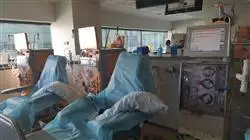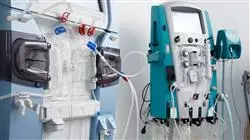University certificate
Scientific endorser

The world's largest faculty of nursing”
Introduction to the Program
Improve your knowledge in Nephrology and Dialysis Nursing through this program, where you will find the best didactic material with real clinical cases. Learn about the latest advances in the specialty to be able to provide excellent medical care"

The program is designed to provide online learning equivalent to 1500 hours of study. All knowledge is presented through high-quality multimedia content, analysis of clinical cases prepared by experts, classes, and video techniques that allow the exchange of knowledge and experience, maintain and update the skill level of its members, create protocols for action and disseminate the most important developments in the specialty. With this online program, students can organize their time and pace of learning, adapting it to their schedules, in addition to being able to access the contents from any computer or mobile device.
The aim of this course is to enrich, renew and enhance professional learning as well as update knowledge of the latest techniques and procedures that a chronic renal patient requires.
We are committed to educating and bringing up to date the ideas and concepts used in nursing. These are based on the best available evidence as pillars of utmost importance for the improvement of the nursing care that we provide to our patients on a daily basis. Professionals must receive appropriate education and information from healthcare institutions as an integral part of their professional careers, if they are to improve the quality of care and provide excellence as the main aim of their care. But we must not forget that the nursing professionals themselves have an intrinsic responsibility and personal involvement to ensure that their knowledge of renal replacement care and techniques is kept up to date.
Update your knowledge through this Professional master’s degree in Nephrology and Dialysis Nursing”
This Professional master’s degree in Nephrology and Dialysis Nursing contains the most complete and up-to-date scientific program on the market. The most important features include:
- More than 75 clinical cases presented by experts in Nephrology and Dialysis Nursing
- The graphic, schematic, and practical contents with which they are created provide scientific and practical information on the disciplines that are essential for professional practice
- The latest information on care and intervention in Nephrology and Dialysis Nursing
- Practical exercises where the self-evaluation process can be carried out to improve learning
- Algorithm-based interactive learning system for decision-making in the situations that are presented to the student
- With special emphasis on evidence-based nursing and research methodologies in Nephrology and Dialysis Nursing
- All of this will be complemented by theoretical lessons, questions to the expert, debate forums on controversial topics, and individual reflection assignments
- Content that is accessible from any fixed or portable device with an Internet connection
This Professional master’s degree may be the best investment you can make when selecting an up-to-date programme for two reasons: in addition to updating your knowledge in Nephrology and Dialysis Nursing, you will obtain a qualification from TECH Global University”
The teaching staff of this program includes professionals from the industry, who contribute the experience of their work to this program, in addition to recognized specialists from reference societies and prestigious universities.
The multimedia content, developed with the latest educational technology, will provide the professional with situated and contextual learning, i.e., a simulated environment that will provide immersive learning programmed to learn in real situations.
This program is designed around Problem-Based Learning, whereby the professional must try to solve the different professional practice situations that arise throughout the program. For this purpose, the student will be assisted by an innovative interactive video system created by renowned and experienced experts.
Increase your decision-making confidence by updating your knowledge through this Professional master’s degree"

Take the opportunity to learn about the latest advances in Nephrology and Dialysis Nursing and improve your patient care"
Why study at TECH?
TECH is the world’s largest online university. With an impressive catalog of more than 14,000 university programs available in 11 languages, it is positioned as a leader in employability, with a 99% job placement rate. In addition, it relies on an enormous faculty of more than 6,000 professors of the highest international renown.

Study at the world's largest online university and guarantee your professional success. The future starts at TECH”
The world’s best online university according to FORBES
The prestigious Forbes magazine, specialized in business and finance, has highlighted TECH as “the world's best online university” This is what they have recently stated in an article in their digital edition in which they echo the success story of this institution, “thanks to the academic offer it provides, the selection of its teaching staff, and an innovative learning method aimed at educating the professionals of the future”
A revolutionary study method, a cutting-edge faculty and a practical focus: the key to TECH's success.
The most complete study plans on the university scene
TECH offers the most complete study plans on the university scene, with syllabuses that cover fundamental concepts and, at the same time, the main scientific advances in their specific scientific areas. In addition, these programs are continuously being updated to guarantee students the academic vanguard and the most in-demand professional skills. In this way, the university's qualifications provide its graduates with a significant advantage to propel their careers to success.
TECH offers the most comprehensive and intensive study plans on the current university scene.
A world-class teaching staff
TECH's teaching staff is made up of more than 6,000 professors with the highest international recognition. Professors, researchers and top executives of multinational companies, including Isaiah Covington, performance coach of the Boston Celtics; Magda Romanska, principal investigator at Harvard MetaLAB; Ignacio Wistumba, chairman of the department of translational molecular pathology at MD Anderson Cancer Center; and D.W. Pine, creative director of TIME magazine, among others.
Internationally renowned experts, specialized in different branches of Health, Technology, Communication and Business, form part of the TECH faculty.
A unique learning method
TECH is the first university to use Relearning in all its programs. It is the best online learning methodology, accredited with international teaching quality certifications, provided by prestigious educational agencies. In addition, this disruptive educational model is complemented with the “Case Method”, thereby setting up a unique online teaching strategy. Innovative teaching resources are also implemented, including detailed videos, infographics and interactive summaries.
TECH combines Relearning and the Case Method in all its university programs to guarantee excellent theoretical and practical learning, studying whenever and wherever you want.
The world's largest online university
TECH is the world’s largest online university. We are the largest educational institution, with the best and widest online educational catalog, one hundred percent online and covering the vast majority of areas of knowledge. We offer a large selection of our own degrees and accredited online undergraduate and postgraduate degrees. In total, more than 14,000 university degrees, in eleven different languages, make us the largest educational largest in the world.
TECH has the world's most extensive catalog of academic and official programs, available in more than 11 languages.
Google Premier Partner
The American technology giant has awarded TECH the Google Google Premier Partner badge. This award, which is only available to 3% of the world's companies, highlights the efficient, flexible and tailored experience that this university provides to students. The recognition as a Google Premier Partner not only accredits the maximum rigor, performance and investment in TECH's digital infrastructures, but also places this university as one of the world's leading technology companies.
Google has positioned TECH in the top 3% of the world's most important technology companies by awarding it its Google Premier Partner badge.
The official online university of the NBA
TECH is the official online university of the NBA. Thanks to our agreement with the biggest league in basketball, we offer our students exclusive university programs, as well as a wide variety of educational resources focused on the business of the league and other areas of the sports industry. Each program is made up of a uniquely designed syllabus and features exceptional guest hosts: professionals with a distinguished sports background who will offer their expertise on the most relevant topics.
TECH has been selected by the NBA, the world's top basketball league, as its official online university.
The top-rated university by its students
Students have positioned TECH as the world's top-rated university on the main review websites, with a highest rating of 4.9 out of 5, obtained from more than 1,000 reviews. These results consolidate TECH as the benchmark university institution at an international level, reflecting the excellence and positive impact of its educational model.” reflecting the excellence and positive impact of its educational model.”
TECH is the world’s top-rated university by its students.
Leaders in employability
TECH has managed to become the leading university in employability. 99% of its students obtain jobs in the academic field they have studied, within one year of completing any of the university's programs. A similar number achieve immediate career enhancement. All this thanks to a study methodology that bases its effectiveness on the acquisition of practical skills, which are absolutely necessary for professional development.
99% of TECH graduates find a job within a year of completing their studies.
Professional Master's Degree's Degree's Degree in Nephrology and Dialysis Nursing
Renal failure is a problem that affects millions of people around the world, its affection to the quality of life is a fact which must be counteracted with high level medical assistance. The Professional Professional Professional Professional Master's Degree's Degree's Degree in Nephrology and Dialysis Nursing of TECH Global University has as its main objective to provide the best training in this indispensable medical discipline, to achieve our goal, we structure the program with an updated study plan in the most recent advances in the field. With the knowledge acquired throughout the Postgraduate Certificate, the student will be able to perform an efficient monitoring, optimizing the quality and patient care with the application of innovative tools and techniques associated with kidney damage.
Study a postgraduate program in nephrology and dialysis nursing 100% online
This TECH program has sophisticated thematic axes, along which students will acquire new knowledge related to: substitutive treatments, nursing process in the chronic patient, palliative care, application of information and communication technologies, among other topics of great academic value. Similarly, in this TECH program we will provide the necessary tools to venture into research development, so that the student can provide new alternatives to improve the quality of life of affected people.







